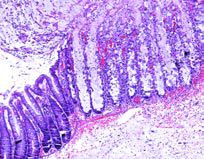 In a new study released on Sunday, August 21, 2011, Scientists from the University of Texas, Case Western Reserve, and Tufts said they may have discovered a natural defense mechanism in cells that fights off the invasion of C. difficile bacteria (commonly called “C-Diff” or “C-Dif”).
In a new study released on Sunday, August 21, 2011, Scientists from the University of Texas, Case Western Reserve, and Tufts said they may have discovered a natural defense mechanism in cells that fights off the invasion of C. difficile bacteria (commonly called “C-Diff” or “C-Dif”).
This could be a significant break-through toward finding a treatment for C-Diff other than the customary use of antibiotics which builds up antibiotic resistance, kills off natural bacteria needed to fight C-Diff, and often leads to multiple recurrences of the C-Diff infection. C-Diff, a serious infection commonly acquired in hospitals and nursing homes, is a particular threat to the elderly.
C-Diff and its Threat to the Elderly
C-Diff (a bacterial infection associated with an extreme form of diarrhea with green and bloody stools, inflammation of the colon or colitis, excessive dehydration and weakening of the body) is the most common cause of hospital-acquired and nursing home-acquired bacterial infections.
In its worst form, C-Diff can lead to death if not effectively treated. C-Diff is notably difficult to treat. It is resistant to most antibiotics (usually responds only to flagyl or vancomycin, the later being extremely expensive), and even if controlled by a course of these antibiotics, lives on in the gut and tends to recur multiple times.
The antibiotics kill off other natural bacteria in the gut, which are needed to fight off C-Diff, and allow the C-Diff bacteria to live on and flourish, eventually attacking again. Moreover, repeated treatments with a course of antibiotics can lead to a build up of further antibiotic resistance by the bacteria and a weakening of the immune system of the patient.
The elderly with weakened immune systems are particularly vulnerable to this serious and increasingly common infection that is contracted and spread in hospitals and nursing homes.
“Between 1 to 2 percent of patients who go into the hospital will develop this,” Tor Savidge of the University of Texas Medical Branch at Galveston, principal author of the new study, told Reuters.
“This [C-Diff] is a $3.5 billion problem in the U.S. alone and it’s rising rapidly because of new, even more virulent strains,” Dr. Savidge said.
The New Study
The new study, by Tor Savidge of the University of Texas Medical Branch at Galveston and his colleagues from the University of California, Los Angeles, Case Western Reserve University, Tufts University and the Commonwealth Medical College, was published on August 21, 2011 in the journal Nature Medicine.
The researchers report that they may have discovered a naturally produced compound that serves as a natural defense mechanism used by cells in the gut to neutralize the harmful toxins produced by C-Diff.
The researchers tested an experimental compound that mimics this natural defense mechanism in studies conducted on laboratory mice, and found promising results. They said that they are planning human clinical trials next.
According to a report on the study by Reuters, in their laboratory studies, the researchers observed that C-Diff toxins infect the cells lining the intestine by producing a molecular guillotine (called a “cysteine protease”) which dissolves the C-Diff toxins into a form capable of entering into the cells lining the gut. The cysteine protease becomes active only when a molecule called “InsP6″ is present in large concentrations inside a cell. Once inside the cells lining the intestine, the C-Diff toxin kills them off, triggering inflammation and diarrhea.
According to the Reuters report, “Savidge’s team discovered that once this process starts, the body releases neutralizing chemicals that gum up the molecular guillotine, preventing the toxins from being chopped up and damaging the cell.”
Drawing their inspiration from this natural mechanism, the researchers developed an experimental treatment compound or drug that mimics this natural process, inhibiting the guillotine, which in turn prevents the toxin from damaging the cell.
“If you shut them down before they can interact with the cell we can alleviate the disease,” Dr. Savidge told Reuters.
The researchers found that laboratory mice with C-Diff, when treated with the experimental drug, improved in their condition and were more likely to survive their infections than mice that did not receive the treatment.
Implications
This new treatment, if proved effective in humans, could potentially neutralize the C-Diff toxins living in a patient’s gut, preventing them from attacking the normal cells lining the intestine, while allowing the normal, protective bacteria in the gut to remain intact.
“This may prove to be an alternative to antibiotics,” Savidge said. But, he cautioned that much more work is needed.
“This needs to be confirmed with additional studies and additional groups will need to confirm it as well,” the author said.
More Information
See the HelpingYouCare™ resource pages on C-Dif/ Extreme Diarrhea, including:
Latest News on C-Dif/ Extreme Diarrhea
Treatment and
_____________
Copyright © 2011 Care-Help LLC, publisher of HelpingYouCare™.












Recent Comments from our Online Community